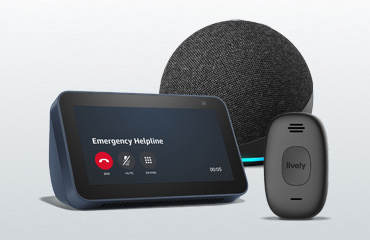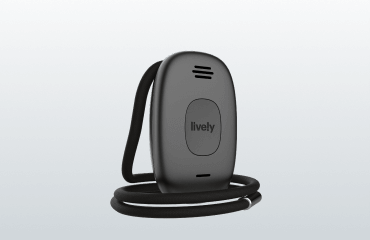Suffering a health emergency and being incapable of calling for help can be one of the biggest worries facing seniors who live alone. This anxiety is often shared by family members and caregivers, especially if the senior has a medical history that causes them to be at a higher risk of medical emergencies. Mobile medical alert systems, also known as wireless medical alert systems, deliver 24/7 emergency monitoring in the home and on the go. These devices are intended to communicate an emergency demanding urgent attention— like a medical emergency, fire, or burglary—and to request emergency medical personnel.
What is a wireless cellular-based medical alert system?
Wireless, cellular-based medical alert systems without landlines are intended to communicate an emergency demanding urgent consideration and to request emergency personnel. Some devices can also notify family members and caregivers of urgent situations.
Some devices can also notify family members and caregivers of urgent situations.
The wireless system operates with a single push of a button, working over the same national cellular telephone networks like those used for cell phone service. This cellular signal is 100% wireless and can be used wherever mobile telephone service is available. Many wireless alert devices also incorporate a GPS location tracking feature for added peace of mind.
How does a wireless medical alert system work?
When the wireless medical alert system is activated during an emergency, a signal is sent to an emergency monitoring center . The situation is then evaluated by highly trained monitoring center staff who can, if necessary, dispatch emergency personnel or call family members or caregivers.
How are wireless medical alert systems different from older alert systems?
A medical alert system is a smart investment for any senior who lives alone and wants the added protection in the event of an emergency. Medical alert systems have changed quite a bit over the years. There are two types of systems: wireless and stationary medical alert systems.
Wireless medical alert systems are designed to be operated inside and outside of your home by people who are independent and not homebound. Since there is not a stationary base unit with a cellular system, communication with the urgent response center happens through the wearable device. Additionally, wireless units are powered either through an extended-life battery or a rechargeable battery.
Wireless systems also include additional options not feasible with a stationary alert system, like GPS tracking. Certain GPS-enabled wearable cellular devices incorporate Wi-Fi locating, utilized to locate the senior when lost, confused, or injured outside the home.
…systems also include additional options not feasible with a stationary alert system, like GPS tracking.
Stationary medical alert systems are designed to work generally less than 1,000 feet within the home. These older alert systems consist of two elements: a stationary console or base unit and a pendant with a help button. When this system is activated, your home is electronically monitored by the base unit that is plugged into an electrical outlet and telephone jack. The pendant is worn around your neck, on your wrist, or clipped to your clothing.
If an emergency occurs, a simple push of the pendant’s help button sends a wireless signal to the base station that calls the U.S.-based emergency monitoring center. A monitoring center agent will assess the situation and then call emergency medical personnel or your emergency contact numbers. The emergency monitoring center is available 24/7.
Pros and cons of a wireless system
A medical alert system is your link to getting the assistance you need when you need it. Wireless medical alert devices have advantages and even some disadvantages. Here are a few things to consider when contemplating a wireless device investment:
Pros of wireless medical alert systems
Flexibility. One of the most significant benefits of a wireless-based system is the flexibility to effortlessly use the system anywhere there is cellular service. Cellular networks are often a great option to cover areas where it is not possible to install a traditional landline.
Freedom. A wireless medical alert system is an ideal solution for seniors who wish to remain active and independent, while also offering a little extra security. Because the devices are not connected to a base unit, they afford the wearer the freedom to travel farther from home compared to the landline units.
No dedicated phone line required. Wireless systems do not require a landline. This device uses the cellular network to connect you with the 24/7 urgent response center should an emergency arise at the push of a button. This system is popular with seniors wanting to live at home while preserving their independence.
Easy setup. Most wireless systems come with an easy, plug and play setup process. This means you just press the button to set up the device. Once the system is active, it uses a cellular signal (like a cellphone) to communicate with the monitoring center.
Range. The range of any medical alert system is an important feature to consider. A wireless device uses a cellular signal to communicate and has an unlimited range within the available cellular service area.
Coverage. Wireless medical alert systems use a cellular signal that connects to an accessible cellphone network. This means your device can be used anywhere, nationwide within the cellphone network of your device.
Dependability. Some wireless systems operate on a single battery for two years, while others may require periodic recharging to maintain dependable service.
Cons of wireless medical alert systems
Feasibility. A landline system may not be a practical option for a senior who is still active in the community, and a wireless system may not be appropriate for a senior who lives in an area without cellular service.
Dead zones. If you live in or are planning to travel to an area with limited cellular coverage, called dead zones, you may not be able to depend on your wireless medical alert system. Always check your network coverage for your area before investing in a wireless alert system.
Costs. The main drawbacks of cellular-based systems are costs. Monthly cellular based systems are typically more expensive in comparison to landline systems. Additionally, there may be activation costs (up to $99) that the user pays upon purchasing a wireless system.
Outages. Cellular networks can experience extended outages. Events like natural disasters can destroy cellular towers and leave you without service for hours or days. Additionally, metropolitan emergencies can overwhelm cellular networks, deeming them unreliable or causing service to be spotty or weak.
When selecting a medical alert system, begin by evaluating your current and future needs and abilities. The most valuable system for you will offer reliable equipment, the features you need to support your lifestyle, and provide 24/7 support.
Here’s more from Lively.
swipe for more
scroll or use your arrow keys for more
scroll for more
use your arrow keys for more



